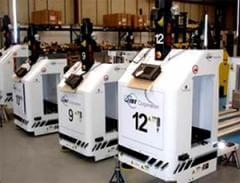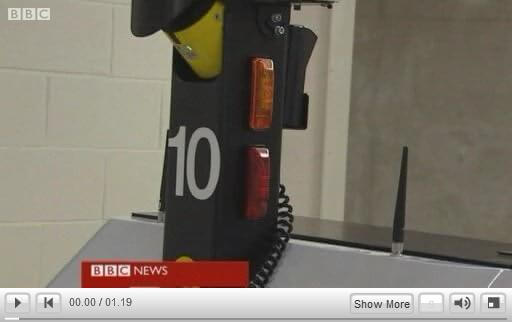
From the first day the Forth Valley Royal Hospital opens in August it will be a shining example of the power of robotics. That’s because the new £300 million Scottish hospital will feature a fleet of robots handling a variety of important tasks. Forklift-like ‘porter’ bots will haul materials to and from rooms, summoned by staff members using PDAs. A robot pharmacy will dispense needed prescriptions. There will even be robotic cleaners for the operating rooms. This is in addition to the advanced MRI, CT scanning, and other semi-automated medical equipment now seen in hospitals all over the world. Forth Valley Royal is a new kind of facility, designed from the ground up to incorporate robotic systems. Click on the image below to see the porter robots in action in a clip from BBC News.
Individually, each of the robotic systems at Forth Valley Royal aren’t new. We’ve seen hauling robots in hospitals before, ditto for robot pharmacists, and cleaning robots (even industrial sterilizing ones) are fairly common now. What is really impressive is the assembly of all of these great technologies in one facility from its inception. This is a new approach to automating the hospital and it could be replicated in locations all over the world. Robotic systems are likely to become a staple of medical centers, giving staffers more free time to handle the really important part of their job: healing patients.

The robot porters in Scotland, however, do more than simply free up time for orderlies and nurses. They go a long way to fighting infection and cross contamination. Because Forth Valley Royal was designed to incorporate the technology, the hospital comes equipped with special hallways for the robots – a sort of behind-the-scenes infrastructure to allow the machines to do their job without interfering with patients and staffers. The same infrastructure allows robots hauling waste, and robots hauling clean supplies to use completely different paths, elevators, and doors. Essentially the clean and dirty loads transported by the bots will never mix (and robots are only assigned one kind of task) so there’s a much lower risk of transmitting infection.
The porter robots are a product of mega-corp Serco Group. A rotating laser sensor at their top helps guide them along their predetermined paths, which are also marked by sensors and beacons. On board communication devices allow automated doors to open and close for the bots, and can call for elevators as needed. I’m not as impressed with these Serco porters as I have been with other systems because they do most of their hauling using special hallways without people. It’s a little easier to get around when there’s not a dozen moving objects walking past you every minute. Still, I should mention that the size of the porter fleet is considerably larger than other such systems we’ve seen in hospitals elsewhere. Dozens of the machines will be in use, including thirteen separate bots which will only come online during peak hours of operation. Coordinating that large of a fleet successfully is an impressive feat.
Of course, using robots for mundane tasks is just the first step towards the future of automated hospitals. For now Forth Valley Royal is simply pursuing greater efficiency, lower risks of infection, and fewer prescription filling errors. We should remember though, that we’ve already seen automated systems that actually help doctors make medical decisions and perform surgeries. Those systems are only going to get better in the years ahead. Whether it happens in Scotland or elsewhere, we’ll eventually see such systems enhance the performance of human medical professionals, allowing one to more and better work. That could lead to a loss of jobs, but it may also lead to doctors having more time to spend with each patient. I for one would welcome a medical professional that has more than five minutes to talk to me when I get sick. Maybe robots can make that happen.
[image credit: Top News]
[screen capture credit: BBC News]
[sources: Forth Valley Royal Hospital, BBC News]



